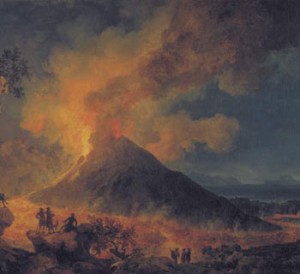New Theory for Vesuvius, 79 AD July 11, 2010
Author: Beach Combing | in : Ancient , trackback
Beachcombing once spent a happy two hours being given electric shocks in an academic hospital in Naples (long story…), the experience leaving him with great fondness for the Frederick II University of that city. So much so, indeed, that he thought that he would give some publicity to a study, Mastrolorenzo et alii, that has recently come, in part, out of the biology faculty there. It is a study that has had little coverage in the English-speaking or English-reading world despite a lead article being published in ‘the international language’.
First, some Vesuvius 101. In 79 AD an eruption of Vesuvius buried Pompeii and surrounding settlements in tonnes of ash giving us moderns the best preserved Roman settlement in Europe and annihilating various unfortunate populations. This ash is a staple of most studies relating to the eruption and stands out in the description of one survivor, Pliny the Younger, who remembers repeatedly brushing the ash off as he fled down the road with his corpulent mother. Bodies at Pompeii were found encased in volcanic ash.
Another volcanic killer was, it is argued, poisonous air that had done for six hundred sheep before the explosion and likely did for Pliny the Elder (Pliny the Younger’s uncle) who had gone to examine the volcano at first hand. The old man did not lack guts, claiming ‘fate will spare the brave’ as he waddled up towards his death. It is a memorable instance of an aphorism badly misleading the aphorist. ‘Fate will spare the brave’, in fact, used to be a favourite of the teenage Beachcombing but Pliny cured him of that.
The new study, however, has looked with care at the remains of the victims of Pompeii and has suggested that most died not from suffocation but from sudden waves of heat, as high as 300 degrees, that swept over the town and cooked the surviving population in seconds – it also melted silverware. In nearby Herculaneum temperatures reached as high as 600 degrees and victims skulls’ exploded. Collectors of trivia might be interested to know that individuals have been known to survive blasts of up to 200 degrees: another way of saying that these poor Romans never had a chance.
Now waves of heat have been there around the margins of earlier studies – usually to be dismissed, at least, for Pompeii – but much has been made in this article of the heat damage to the bones found in the town.
Beachcombing recalls that many at Hiroshima survived quite near ground zero if they were in strong enough buildings. But even house walls gave no protection as Pompeii heated up.
Death would have been instantaneous – the reason so many Pompeians are apparently frozen. Movingly many bodies took on what the study refers to as a ‘pugilistic pose’ as they were baked into time – a last broiling spasm jerking them before or during death. Previous scholars believed that this was a vain attempt at self defence.
Beachcombing does not want to spoil this partial happy ending – ‘instantaneous’ and all that – but it was probably the fourth wave of heat that killed the population: many will have had some inkling of what was coming as early waves had almost reached the city walls… It must also be said that some of the town’s population had already died under collapsing Roman buildings as stones and ash came raining down.
Beachcombing has scribbled a reminder into his filofax diary to stay away from the Bay of Naples in 79 AD. As to modern Naples with Vesuvius fuming over the city…



